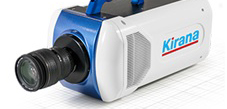The Institute of Engineering Thermodynamics (LTT) at FAU Erlangen-Nürnberg in Germany has tested a Kirana ultra high-speed camera to visualize the transient opening process of fuel-injectors in one of their high-pressure injection chambers.
The LTT builds and runs injection chambers to investigate the transient spray processes within fuel-injectors used in internal combustion engines. Employing an experimental approach of continuously flushed chambers enables high injection rates and therefore time efficient experiments.
This, in combination with the wide range of variable operation parameters, such as chamber pressure, chamber temperature, fuel pressure and fuel temperature, makes the chambers attractive both for fundamental research and testing under application conditions.
Conventional high-speed imaging techniques are already well-established in spray research, but are not able to resolve very fast processes such as spray fluctuations or the injector opening in high spatial resolution, as the fuel leaves the nozzle with up to 300m/s in gasoline injection and even higher velocities when using diesel fuel.
The Kirana ultra high-speed camera from Specialized Imaging closes this gap, able to take 180 consecutive high-quality images at frame rates of up to 5MHz. The full resolution of the Kirana camera is maintained independently of its frame rate, enabling it to achieve high spatial and temporal resolution at the same time.
The Kirana camera was used to visualize the opening of two experimental injectors, a gasoline and a diesel design, using a long distance microscope to achieve high magnifications and focus on the effects directly at the nozzle hole.
The transient opening and closing behavior of fuel-injectors is specifically relevant in application, since it causes a throttled flow that significantly alters the nozzle behavior which can lead to tip wetting, jet-to-jet interaction and other phenomena.
The use of the Kirana ultra high-speed camera not only reduced the measurement time by several orders of magnitude but also provided information about the temporal course of the highly turbulent flow that have not been accessible before.
In the diesel fuel injection experiments, the transition from throttled pre-jet to full needle lift is clearly visible.
To review the exemplary results achieved by the lTT researchers click here.
With the high quality of the results achieved using the Kirana camera, further applications for ultra high-speed measurements in spray research are currently under investigation at the LTT.


